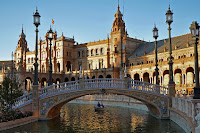The
scent of orange blossom, the thrash of a flamenco guitar, the glimpse
of a white village perched spectacularly atop a crag; memories of
Andalucía stay with you like collected souvenirs.
Part of the
fascination of Andalucía springs from its peculiar history. For eight
centuries the region sat on a porous frontier between two different
faiths and ideologies, Christianity and Islam. Left to ferment like a
barrel of the bone-dry local sherry, the ongoing cross-fertilisation
has thrown up a slew of cultural colossi: ancient mosques transformed
into churches, vast palace complexes replete with stucco, a cuisine
infused with dashes of North African spices, and a chain of lofty white
towns that dominates the arid, craggy landscape from the tightly
knotted lanes of Granada's Albayzín to the hilltop settlements of Cádiz
province.
Immortalised in operas and vividly depicted in 19th-century artworks, Andalucía often acts as a synonym for
Spain
as a whole: a sun-dappled fiesta-loving land of guitar-wielding
troubadours, reckless bullfighters, feisty operatic heroines, and
roguish Roma singers wailing sad laments. While this simplistic
portrait might be outdated and overly romantic, it carries an element
of truth. Andalucía, despite creeping modernisation, remains a spirited
and passionate place where the atmosphere – rather like a good
flamenco performance – creeps up and taps you on the shoulder when you
least expect it.
.jpg)
It takes more than a few thirsty
Costa del Sol
golf courses to steamroller Andalucía’s diverse ecology. Significant
pockets of the region's southern coast remain relatively unblemished,
while inland, you’ll stumble into bucolic, agriculturally dependent
villages where life doesn’t seem to have changed much since playwright
Federico Lorca envisioned
Bodas de Sangre (Blood Wedding).
Twenty percent of Andalucía’s land is sheltered in natural and national
parks, and the protective measures are showing dividends. The Iberian
lynx is no longer impossibly elusive, while the handsome ibex is
positively flourishing. Another laudable reclamation project is the
region’s
vía verdes, old railway lines reborn as biking and hiking greenways.
One of Andalucía's most intriguing and mysterious attractions is the notion of
duende, the elusive spirit that douses much of Spanish art, especially flamenco.
Duende
loosely translates as a moment of heightened emotion experienced
during an artistic performance, and it can be soulfully evoked in
Andalucía if you mingle in the right places. Seek it out in a Lorca
play at a municipal theatre, an organ recital in a Gothic church, the
hit-or-miss spontaneity of a flamenco
peña (club), or the remarkable art renaissance currently gripping
Málaga.


.jpg) It takes more than a few thirsty Costa del Sol
golf courses to steamroller Andalucía’s diverse ecology. Significant
pockets of the region's southern coast remain relatively unblemished,
while inland, you’ll stumble into bucolic, agriculturally dependent
villages where life doesn’t seem to have changed much since playwright
Federico Lorca envisioned Bodas de Sangre (Blood Wedding).
Twenty percent of Andalucía’s land is sheltered in natural and national
parks, and the protective measures are showing dividends. The Iberian
lynx is no longer impossibly elusive, while the handsome ibex is
positively flourishing. Another laudable reclamation project is the
region’s vía verdes, old railway lines reborn as biking and hiking greenways.
It takes more than a few thirsty Costa del Sol
golf courses to steamroller Andalucía’s diverse ecology. Significant
pockets of the region's southern coast remain relatively unblemished,
while inland, you’ll stumble into bucolic, agriculturally dependent
villages where life doesn’t seem to have changed much since playwright
Federico Lorca envisioned Bodas de Sangre (Blood Wedding).
Twenty percent of Andalucía’s land is sheltered in natural and national
parks, and the protective measures are showing dividends. The Iberian
lynx is no longer impossibly elusive, while the handsome ibex is
positively flourishing. Another laudable reclamation project is the
region’s vía verdes, old railway lines reborn as biking and hiking greenways.








.jpg)




.jpg)
.jpg)
.jpg)



.jpg)
.JPG)
.jpg)


.jpg)
.jpg)
.jpg)
.jpg)

.jpg)






Комментариев нет:
Отправить комментарий